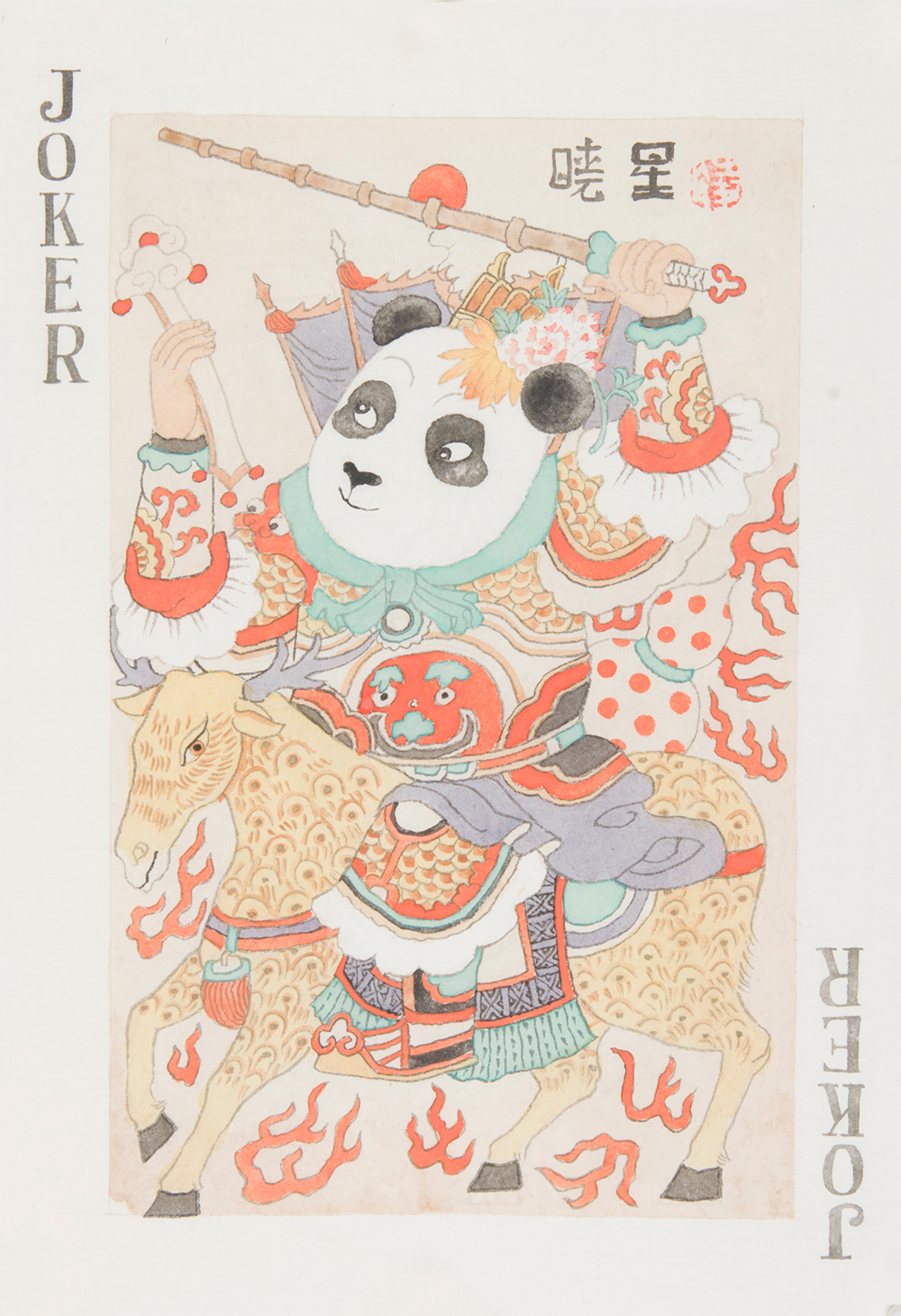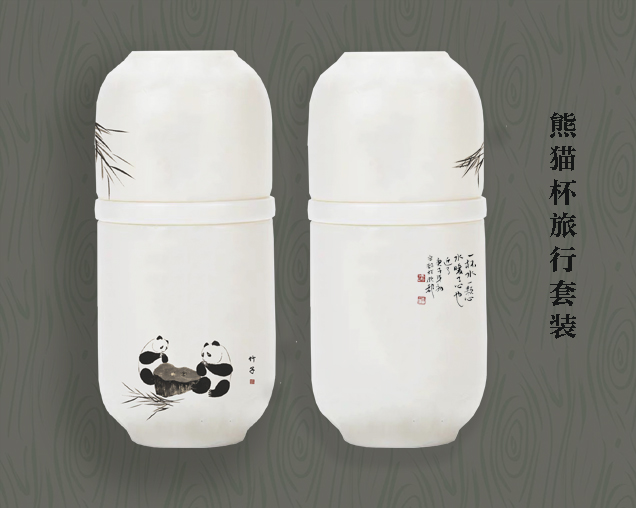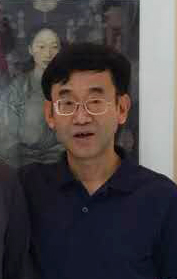透过浪漫与伤感(作者:段炼)
时间:2008-10-30 | 来源:郭燕 |
加拿大康科迪亚大学教授
文学及美术学博士
郭燕是当代美术界新起的女画家,九十年代中期,她毕业于西安美术学院油画系,现在活跃于画坛。郭燕近年的作品,多描绘内心意象,化想象、思考、期翼为一体,风格独特,引起了美术界的关注。
我看郭燕的画,首先被画中不寻常的内心意象所吸引,那就是漂浮在空中的人,这让我联想到俄国现代主义大师夏加尔那些想象力奇特的画面,既充满浪漫的情怀,又有伤感的诗意气质。但是,郭燕与夏加尔的视觉关联仅是一种表象,所谓浪漫,所谓伤感,在这里只是一种风格和形式。郭燕的画来自她所身历的现世生活,画中人物相对写实,而夏加尔关注来世生活,画中人物在浪漫与伤感中多是变形的。
透过浪漫与伤感的表象,我们进一步看郭燕的画,发现她与夏加尔的联系,不是表面的视觉联系,而是内在的精神联系,那就是力图超越现世、追求精神自由。郭燕绘画所展示的是两个世界,一是流云飞渡的长空,二是高楼林立的城市,二者都一片幽深,神秘莫测,既给人自由的空间,又限制了人的自由,恰如人心深处的潜意识世界。在这深邃的天地之间,幽然透出一线光亮,那些漂浮的恋人,就在这光亮的天河里随波逐流。
随波逐流是人在天地之间的梦游,是睡梦与清醒之间的潜意识状态,是一种貌似不自知的自由追求。在这样的意义上说,郭燕笔下的人物,与夏加尔笔下那些天使般的来世恋人有了相通之处:执着的追求,隐藏在不经意的潇洒和散漫中。面对郭燕的画,看到这一步,我们就得提出一个问题:郭燕画中的天使为什么梦游?其实,这也是艺术家要寻求的答案,而答案就在梦游者与城市的关系中,在人与生存环境的关系中,在于画家以睡梦的方式去体验自己的生存状态,去追寻归宿的港湾。
在郭燕的绘画中,艺术家借睡梦来体验自己的内心追求。画面上那些梦游天使几乎没有独眠者,他们要么是分床而卧的男女,要么是同床共枕的情侣或同床异梦的夫妻,要么是相依而眠的母女,要么是各自漂浮的家人。在我看来,画家在此探索和体验的首先是一种形而下的家庭关系,其中既有相互的依存,也有各自的独立。然而,画家的探索也是形而上的,那些漂浮在城市上空的半睡半醒的人,象征着艺术家永不安宁的游荡之魂,既像飞鸟一样追求内心自由,也如倦鸟那般,在城市的楼群森林里,寻找栖息之地。
作为生存环境的象征,画中下界的城市,多是钢筋水泥的莽林。无论凌空俯视,还是侧面剪影,森林般的城市既为人提供了生存条件,也压缩了人的生存空间。即便是身临郊外别墅区的上空,这种欲迎还拒、欲拒还迎的环境,都透露出环境对人的态度,以及人对环境的认识。如前所述,画面上的天际线,都无一例外地在黑暗的茫茫天空和阴森的大地间渗出一丝清冷的晨光,向我们提示了半睡半醒的神志状态。这就是说,在时间和空间的两个维度上,在物理和心理的两个领域里,这状态都向我们这些看画的人,提示了理智与本能的碰撞,提示了尝试和思考的对接,提示了探索和追求的承续。
面对郭燕的绘画,在有了上述解读后,我需要做一点理论的阐述,主要借用英国当代精神分析中的“母婴关系”概念,以求哲学的归纳。在心理学意义上讲,母婴关系影响甚至决定了一个人的心理发展和社会存在。在社会学意义上讲,母婴关系可以延伸为个人与家庭的关系、个人与群体的关系、个人与社会的关系,也可以延伸为人与自然的关系。这种延伸,是一个从形而下到形而上的过程。在艺术心理学和艺术社会学的意义上说,女画家笔下的母婴关系,是对自由程度的尝试,是对精神自由的体验,可以演绎为诸多家庭关系,如夫妻关系、婆媳关系、母子关系等等。实际上,画家本人的家庭角色是变化着的,她既扮演孩子的角色,也扮演母亲的角色,既寻求保护,也给予保护,既寻求自由,也探索自由的限度。这当中的要义,是个人与生存环境的互动关系。
在这样的关系中,个人的行为,是为自己寻求合适的生存位置和足够的自由空间。母婴关系是艺术家在心理漂泊的过程中对归宿感的寻求、尝试和体验,相对于这样的体验,往日艺术理论中的所谓再现客观世界、表现主观世界、探索纯粹形式之类说教,便显得苍白无力。这时,唯有体验,才触及了艺术作为心理治疗和协调机制的要义。因此,我们看郭燕的绘画,不必去看她再现或表现了什么,而应该去悉心感受这位艺术家的内心体验。
艺术家的体验,重在自身内审的心理图像,因而在画面上,人物外在的面部刻画便相对简约甚至模糊,艺术家关注的是个人化的历史意识的心理表述。批评家们当然可以用女性主义理论和方法来解读郭燕的艺术,然而在我眼中,这位画家对母婴关系的体验,是女性的但不一定是女性主义的,因为画家所关注的,是女性作为人所面对的生存环境和社会关系,而不是固执地一味强调女性的性别政治。这就像母婴关系中的母亲,她代表了人的生存环境而不一定非得是具体的母亲,婴儿代表了这个环境中的个人而不一定非得是具体的婴儿,而一位女性艺术家借助绘画来体验母婴关系,则在她想象、思考和期翼的心理过程中,化为对个人的生活历程及其社会存在的视觉表述。
从郭燕的绘画作品中退出来,面对面与这位艺术家交谈,我看到的却是另外一个人,一个温文尔雅、安静秀气的女画家。但我相信,画家的内心世界是不安宁的,正如那天地间透出的一线亮光,正如那些陪伴着梦中天使一道漂浮的流云,画家的内心深处,激流汹涌。这激流,既象冬天封冻的山溪,在冷静的冰面下奔腾不息,也象火山爆发的岩浆,最后凝固成安详的熔岩。
这一切,就是我眼中郭燕的艺术,在浪漫和伤感的表象之下,内心里奔涌着对精神自由的执着追求。
二OO八年七月,成都
Under the Romantic and Sentimental Surface
Duan Lian
Professor of Concordia University Canada
Doctor of Literature and Art
Guo Yan, a young woman painter, graduated from the Oil Painting Department of Xi’an Academy of Fine Arts in the mid 1990s, and has since been active in the Chinese art scene. Most of her recent works put stress on expressing inner images and integrating imagination, consideration and aspiration. The style of her works is rather special and unique, which has drawn the attention of the public and critics alike.
When I look at Guo Yan’s paintings, I am immediately attracted by the unusual imagery. The figure of a man floating in the air makes me think about the imaginative pictures of Marc Chagall, a Russian modernism master, which are romantic and sentimental. However, the visual connection between Guo Yan and Marc Chagall seems only a superficial phenomenon, as all the romance and sentiment in her works is just a question of style and form. Guo Yan’s paintings come from her personal life experiences, and the characters in paintings are relatively realistic, while Marc Chagall pays attention to the afterlife, and most of his characters are anamorphic in the emotion of romance and sentiment.
More careful analysis of the paintings of Guo Yan, reaching beyond the superficial phenomenon of romance and sentiment, reveals that the connection between her work and Marc Chagall’s paintings is not only a visual one. In fact, there exists a different, metaphysical link between these two artists, as they are both looking for transcendence and spiritual freedom. Guo Yan’ works show two worlds, one is the wide sky full of floating clouds, and the other one is cities imbued with high buildings. Both of them are mysterious. This imagery offers people free space, at the same time limiting their freedom, just like our subconscious puts constraints on the conscious actions we perform. In this deep and profound world, there is only a faint light shining in the dark, where the floating lovers share their joy.
The people flying in the bright sky are sleepwalking, suspended between dream and reality. The act of sleepwalking represents their unconscious pursuit of freedom. In this sense again, Guo Yan’s figures are similar to Marc Chagall’s angelical afterlife lovers: persistent pursuit is hidden under what seems to be casual carelessness. Looking at Guo Yan’s pictures, having deciphered and appreciated their true meaning, we are faced with another question: why do the angels from her works wander in sleep? In fact, this is also what the artists wish to find out, and the answer is hidden right in the relation between the sleepwalker and the city, or between the human being and the living environment. The painter tries to render the experience of her own state of mind, using dreams to find out something about her own fate.
In Guo Yan’s paintings, the artist shows her inner pursuit by means of a dream. In her works, the dreaming angels hardly ever sleep alone. There are men and women sleeping separately, lovers sleeping together, a husband and a wife who sleep together but are separated by an emotional gap. Other figures include a mother and a daughter sleeping and nestling together and some family members floating separately. In my opinion, what the painter explores and experiences here firstly is a kind of a metaphysical family relation, where the members rely on each other at the same time being independent people. Moreover, the painter’s exploration also has a metaphysical dimension. Those half-awakened people who float in the sky over the city stand for the artist’s restless soul. They are like birds pursuing their freedom, and like tired birds find rest in the forest of the city buildings.
As the symbol of living environment, most cities in the pictures are wild forests of reinforced cement. Even though there is the sky above, it is the forest-like city that offers people a place to live and squeezes their living space. As mentioned above, the horizon in the pictures leaks a little light and cool twilight to the completely dark lonesome sky and somber earth, which suggests a half-awakened spiritual state. That is to say, in the dimensions of time and space, in the areas of physics and psychology, this state suggests to us the contradiction of sense and sensibility, the link between the heart and the reason, as well as the inheritance of exploration and pursuit of freedom.
Facing Guo Yan’s works and having the understanding of the above mentioned points, we could reach a philosophical conclusion, using as the theoretical background the concept of “mother-infant relationship” developed by the modern British psychoanalysis. From the philosophical perspective, mother-infant relationship influences or even determines person’s mental development and social existence. From the sociological point of view, this relationship can be further considered as a relation between individual and family, between individual and group, and between individual and society. Moreover, it can also be regarded as a relation between human and nature. From the point of view of art psychology and art sociology, the mother-infant relationship showing in Guo Yan’s pictures is an attempt to set herself free, and as such is an experience of spiritual freedom. This attempt and experience can be expressed by many family relations: such as the relation between husband and wife, between mother and daughter-in-law and between mother and son, etc. As a matter of fact, painter’s own family role is changing, she plays the role of both a child and a mother, so she needs to be protected while she protects others, and she pursues freedom while exploring the limitations of the freedom of others. The nature of these relations is the interaction between individual and living environment.
In such a relation, the individual naturally aims to achieve suitable living conditions and enough free space. Mother-infant relationship represents also the artist’s pursuit and experience of destiny in the process of spiritual search. Compared with such an experience, the whole theory of art, based on the representation of the objective world, showing subjective world or exploring pure form, seems weak and powerless. Here, only the true experiences touch the nature of art as psychotherapy and coordination mechanism. Therefore, when we appreciate Guo Yan’ works, the representations and forms of expression are of secondary importance, all we should do is concentrate on the feelings provoked by the artist’s personal experience.
The experiences of the artist emphasize the mental image of inner exploration, so the facial features of depicted characters are relatively simple or even ambiguous, because what artists pays attention to is the mental expression of individualized historical consciousness. Critics can of course apply feminist theory to Guo Yan’s paintings, but to me, the painter’s experience comes from the female perspective, and absolutely not the feminist perspective. What the painter values is the living environment and social relations that women face as human beings, rather than repeatedly emphasized gender politics. Just like the mother in the mother-infant relationship represents human living environment and not any specific mother, the infant stands for an individual in environment not a specific infant. A women artist experiences mother-infant relationship by means of painting, and transfers it to the visual expression of individual’s life path and social existence in her mental process of imagination, consideration and expectation.
Turning back from Guo Yan’s works towards the young artist herself, when I met her in person I saw a gentle, cultivated, quiet and polite woman painter whose character is totally different from that of the figures in her paintings. However, I believe that she must own a wild inner world just like that faint light and those floating clouds following the angel in the dream. And she must have a heart full of enthusiasm and passion. The passion is just like a frozen stream in the wintertime, surging under the ice, and the enthusiasm just like the magma of the volcano explosion, the freezing lava.
In my view, Guo Yan’s art is mostly about firmly pursuing spiritual freedom and reaching beyond the superficial phenomenon of romance and sentiment.
Chengdu, July 2008
>相关报道:
- ·别江书法作品{苏轼诗一首}[2022-03-07]
- ·素心若兰[2022-03-07]
- ·别江喜迎冬奥书法作品[2022-03-07]
- ·蘇轼诗一首[2022-03-07]
- ·虎跃龙腾[2022-03-07]
- ·别江书法{庆祝第二个警察节}[2021-12-30]
热点新闻
艺术家推荐
更多...曹辉 1952年生于成都。中国美术家协会会员,国家一级美术师,四川美术家协会理事、四川美术家协会中国画艺委会人物画专委会特邀委员、成都中国画会副会长、成都大学中国东盟艺术学院客座教授,硕士生校外导师,成都惠民职工画院顾问。上世纪八、九十年代,其连环画作品多次获得全国大奖。1999年国画《川妹子出川图》获文化部全国第八届“群星奖”银奖;1990~1998年连续在法国举办五次个人作品展。2011年获第一届四川省工笔画学会作品展暨中国工笔画名家邀请展银奖。2014年作品《锦江花月夜》参加四川省诗书画院三十年创作成果展•全国书画名家作品邀请展。2015年作品参加在中国国家画院美术馆举行的“新中国美术家系列·四川省国画作品展”;2016年在四川美术馆举办个人作品展;2016年12月作品受邀参加“回望东坡“2016四川中国书画创作学术邀请展;2017年3月作品受邀参加水墨四川 ——名家作品邀请展;2017年5月作品《锦官城外》受邀参见“守墨鼎新”四川省政协书画研究院作品展;2017年8月作品《年夜饭》参加在香港会议展览中心举办的全球水墨画大展;2018年1月27日在香港云峰画苑总部举行“昔日情怀--曹辉艺术作品展”,并由此开始为期一年的全国巡展。 曹辉1982——2002年发表作品: 《神奇的武夷山悬棺》连环画《奥秘》画报 1982年4期 《给上帝的一封信》连环画《连环画报》 1983年3期 《神秘的大旋涡》连环画《奥秘》画报 1983年2期 《野人之谜新探索》连环画《奥秘》画报 1984年1期 《女子足球运动》连环画《奥秘》画报 1985年5期 《女子马拉松》连环画《奥秘》画报 1985年2期 《小酒桶》连环画《连环画报》 1984年3期 《神秘的石室》连环画《奥秘》画报 1984年4期 《战神之墙》连环画《奥秘》画报 1985年9期 《笔录奇观》连环画《奥秘》画报 1985年11期 《古代美容》连环画《奥秘》画报 1986年6期 《一个女研究生的堕落》连环画广东《法制画报》 85年1、2期 《一个投案者的自述》连环画广东《法制画报》 85年17期 《ET外星人》连环画《奥秘》画报 85年4、5期 《孟卖大爆炸》连环画《奥秘》画报 1987年5期 《热爱生命》连环画《奥秘》画报 1989年1期 《驼峰上的爱》连环画《奥秘》画报 1989年9期 《青鱼》连环画《连环画报》 1985年3期 《珍珠》连环画《连环画报》 1986年3期 《菩萨的汇款》连环画《连环画报》 1985年9期 《小耗子》连环画《连环画报》 1986年10期 《水手长接替我》连环画《中国连环画》 1986年10期 《征服死亡的人》连环画《中国连环画》 1987年6期 《小酒桶》 连环画中国农村读物出版社再版 1985年11版 《给上帝的一封信》 连环画中国连环画出版社再版 84年3期 《日本国技.相扑》 连环画《奥秘》画报 1986年1期 《圣地亚哥刑场》 连环画《奥秘》画报 1987年10期 《古诗意画》 国画 四川美术出版社 1987年5版 《人蚊之战》 连环画 科学文艺 1988年1期 《跳水 》 连环画 《万花筒画报》 1988年2期 《他们与“森林野人”》连环画《奥秘》画报 1988年3期 《圣地亚哥刑场》 选刊 《中国连环画艺术》 1988年3版 《关于圣地亚哥刑场的通信》 论文 《中国连环画艺术》 1988年3版 《阿拉斯加的奇遇》 连环画《奥秘》画报 1989年1期 《祭火》 连环画 《中国连环画艺术》 1989年6版 《辟古奇谭》 连环画《奥秘》画报 1989年6期 《玛丘皮丘》连环画《奥秘》画报 1989年9期 《医生.夫人.闹钟》连环画《奥秘》画报 1990年1期 《南.马特尔之谜》连环画《奥秘》画报 1990年10期 《泉神娶妻》连环画《奥秘》画报 1991年1期 《中国民族民俗故事》 连环画明天出版社出版 1991年1版 《船儿水上飘》 国画 蓉城翰墨 1991年12版 《萨克奇野人的俘虏》连环画《奥秘》画报 1991年10期 《圣经的故事》 连环画四川美术出版社 1992年1版 《雪莲洞探秘》连环画《奥秘》画报 1992年2期 《艾科沟之谜》连环画《奥秘》画报 1992年5期 《印度河文明之谜》连环画《奥秘》画报 1993年1期 《干冰杀人案》连环画《奥秘》画报 1993年5期 《白色幽灵》 连环画 《中国连环画》 1993年4期 《悬棺之谜新解》连环画《奥秘》画报 1993年8期 《冤家变亲家》连环画《连环画报》 1993年10期 《一棵遗落在荒原的种子》连环画《连环画报》 1994年6期 《世界名人传记.艺术家卷 米勒篇 》 连环画浙江少儿社 94年一版 《巴仑克之谜》连环画《奥秘》画报 1994年10期 《辟古奇尼》连环画《奥秘》画报 1995年5期 《豹狼的日子》 上、下连环画 中国连环画出版社 1992年10版 《冬之门 》连环画《中国连环画》 1995年8,9期 《神农架野人今安在》连环画《奥秘》画报 1997年1期 《寻觅玛雅古城》连环画《奥秘》画报 1997年10期 《白鹤梁探秘》连环画《奥秘》画报 1998年1期 《尊严》连环画《中国连环画》 1998年2期 《神秘的南美大隧道》连环画《奥秘》画报 1999年2期 《名医入地彀》连环画《连环画报》 1999年6期 《神秘的英国巨石圈》连环画《奥秘》画报 1999年5期 《蜀王陵出土记》 连环画《奥秘》画报 2000年8期 《定数》连环画《连环画报》 2000年10期 《印山大墓揭秘》连环画《奥秘》画报 2001年5期 《冰封印加之谜》连环画《奥秘》画报 2001年8期 《“狼人”之谜》连环画《奥秘》画报 2002年1期 《扣开通往远古的大门》连环画《奥秘》画报 2002年4期 曹辉艺术年表: 2020年1月在成都举办“陌上谁人依旧 · 曹辉民国风人物画展” 2019年11月作品受邀参加四川省诗书画院主办的“回望东坡•2019四川中国书画学术邀请展” 2019年8月中山(南区)云峰画苑于举办《昔日情怀-曹辉艺术作品展》 2018年10月作品受邀参见“天府百年美术文献展” 2018年1月27日在香港云峰画苑总部举行“昔日情怀--曹辉艺术作品展” 2017年8月作品《年夜饭》参加在香港会议展览中心举办的全球水墨画大展 2017年5月作品《锦官城外》受邀参见“守墨鼎新”四川省政协书画研究院作品展 2017年3月作品受邀参加水墨四川 ——名家作品邀请展 2016年12月作品受邀参加“回望东坡“2016四川中国书画创作学术邀请展 2016年6月 在四川美术馆举办个人作品展 2016年5月 作品《绣娘》参加成都重大题材美术创作工程开篇之作——南方丝绸之路美术作品展 2015年11月 作品《故园旧梦》入选第二届“四川文华奖”美术书法展,并获三等奖 2015年11月 作品参加由四川省艺术研究院主办的“2015四川中国画创作学术邀请展” 2015年10月 作品《西厢待月》参加在重庆举办的“中国精神•民族魂——中国知名画派邀请展” 2015年10月 作品《故园旧梦》参加“从解放碑到宽巷子”2015成渝美术双百名家双城展 2015年9月 作品参加成都市推广天府画派办公室主办的“传神写照•2015水墨人物画邀请展” 2015年8月 特邀参加成都市推广天府画派办公室主办的“心里画儿•中国画邀请展” 2015年5月 特邀参加由四川省美协和四川省美协中国画艺委会联合主办的“四川省中国画人物画作品展” 2015年4月 参加在中国国家画院美术馆举办的“新中国美术家系列•四川省国画作品展” 2014年 作品《锦江花月夜》参加四川省诗书画院三十年创作成果展•全国书画名家作品邀请展 2014年7月 三幅作品参加“南方丝绸之路”主题创作展 2011年5月 在成都东方绘画艺术院(现在的二酉山房)举办“曹辉人物画作品展” 2011年3月 《曹家大院•家训》获首届四川工笔画学会作品展暨中国工笔画名家邀请展银奖 1999年 国画《川妹子出川图》获文化部全国第八届“群星奖”银奖 1999年 连环画《名医入彀》获《连环画报》“十佳”优秀绘画奖 1998年8月 在法国圣雷米市BAYOL画廊举办第五次个展 1996年 作品《寻找北斗》获四川省优秀作品奖 1995年7月 在法国圣雷米市BAYOL画廊举办第四次个展 1993年9月 在巴黎“中国之家”画廊举办第三次个展 1993年 连环画《白色幽灵》获《中国连环画》“十佳”作品奖 1991年5月 在巴黎亚洲民俗艺术博物馆举办第二次个展 1990年3月 在巴黎亚洲民俗艺术博物馆举办第一次个展 1990年 连环画《圣地亚哥刑场》获《奥秘》画报1985~1990年“十佳”优秀作品奖 1989年 连环画《圣经的故事》《青鱼》入选第七届全国美展,获四川省优秀作品奖 1986年 连环画《罗瑞卿的青少年时代》获第三届全国连环画评奖三等奖 1981年 国画《新户头》获四川省优秀作品奖详情>>



 保存
保存 打印
打印



最新评论
已有0条评论,共0人参与